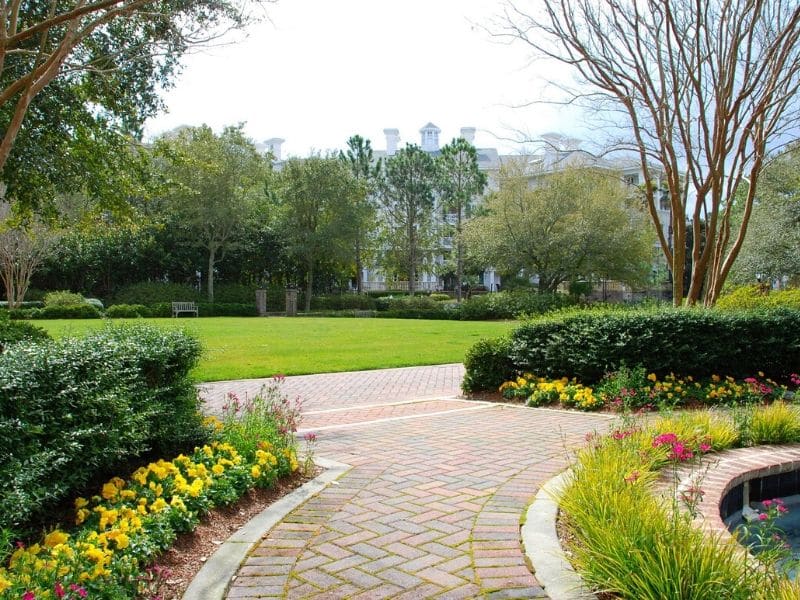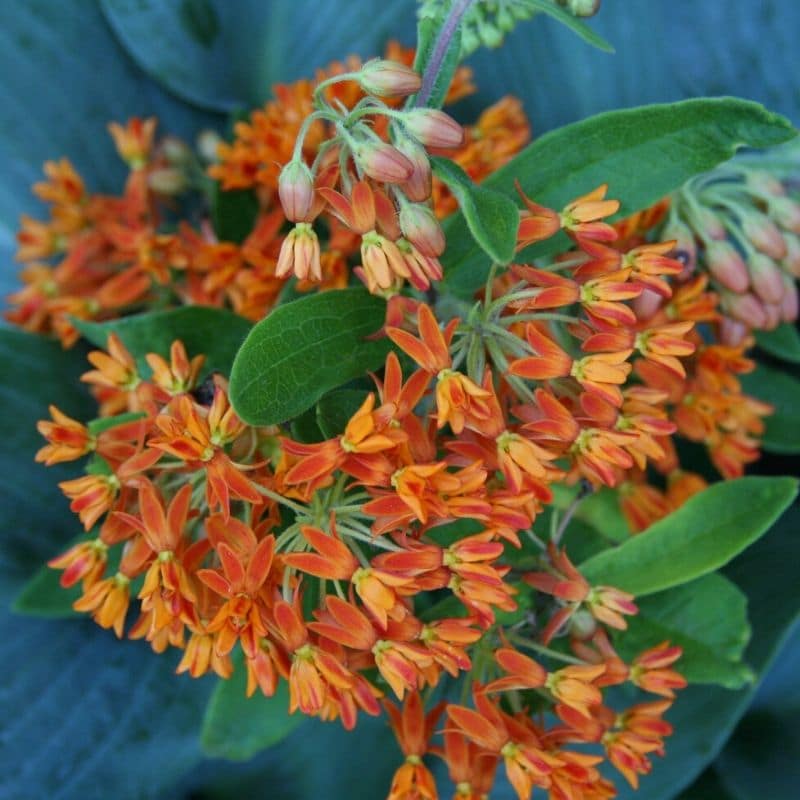Border Plants are accent plants planted along the edges of gardens. These plants come in an array of heights, generally beginning with short varieties of less than 18 inches in the front of the garden and progressing to about 3 feet high in the middle.
Border plants greater than 3 feet tall are generally placed at the back of the garden borders.
Uses of Border Plants

Garden designers use border plants as elements of a composition as well as artistic components. Often, border plants help blend surrounding areas by creating gentle transitions or connections in the landscape. Sometimes they create boundaries between garden areas.
They are used along driveways, cottage gardens, narrow walks and almost any type of pathway or garden imaginable. Some borders are strictly for aesthetic beauty while others lend themselves to creating boundaries for raised or even boxed flower beds.
Border plants help keep edges secure and reduce erosion. In other cases, border plants may be used to increase cross-pollination or deter certain types of insects or other garden pests. In other landscape designs, edging plants create visual or physical barriers.

What To Consider When Choosing Border Plants
Choosing perfect border plants involves balancing the garden’s features with the plants’ needs. Consider size, sun, water, wind, soil, and hardiness zones.
Beyond those basics, research upkeep, bloom times, heights, and even how to divide and replant. Remember, the plants’ growth habit, foliage, and even color should harmonize with the environment.
For a stunning result, limit yourself to 6 or fewer plant types, grouped in eye-catching clusters. This scheme simplifies care and creates a more impactful visual display.

Planning Your Border Plant Design
Border plants play a crucial role in enhancing the visual appeal of a garden, providing breathtaking color and solid texture. When researching, prioritize characteristics that complement the grace and beauty of focal point plants, considering various shapes and structures.
Categorize border plants by height, trailing abilities, climbing tendencies, spreading types, and geometric shapes, encompassing mats, mounds, spikes, arches, fountains, cones, and globes.
These plants should act as the workhorses that unify the garden, creating a dynamic horizontal plane of dimension and color. Selecting border plants can serve specific purposes, contributing purpose, grace, loveliness, and features tailored to your desires, such as addressing growing conditions, deer resistance, drought tolerance, and attractiveness to pollinators, among other attributes.

Options for Designing Borders
Designing borders with edging plants involves selecting compatible ones based on personal preferences, gardening skills, and botanical knowledge.
A successful blueprint emphasizes a harmonious composition with shorter plants in the front and taller ones in the back, showcasing favorite selections.
Consideration of various border shapes and sizes allows for personal expression in gardening design. It’s crucial to ensure chosen border plants align with the garden’s theme, and meticulous preparation, including planning, research, and soil preparation, is vital for a thriving garden.

Commercial Options for Borders
For those feeling overwhelmed or lacking time to design their own border plant template, specialized companies offer ready-made templates, eliminating guesswork and potential mistakes, particularly beneficial for amateur gardeners.
These templates cater to specific garden types, including those attracting bees and butterflies, evergreen, or suitable for sunny or shady locations. Preprinted border designs on biodegradable paper provide a straightforward option, where you lay out the paper in the desired location and plant through it.
Alternatively, if opting for a DIY approach, creating a plant selection chart becomes essential. This tool aids in organizing plant data, facilitating informed choices, and maintaining records for future garden planning.

Organizing Your Potential Border Plants
Create a comprehensive plant chart, whether handwritten or computer-generated, with segregated sections by plant type. Include meanings of abbreviations for future reference.
Continuously update the chart with interesting border plant specimens. Research, planning, and documentation are key to a successful border plant garden.
When sketching your garden, focus on edging plants using the chart to select specimens based on size, type, maintenance needs, textures, shapes, and colors. Choose plants that enhance the garden’s flow into its surroundings, remembering the limitless options for border plant choices.
Types of Edging Plants for Your Garden
Here are six examples of delightful border and hedging plants. For more flowering plants that you can use for walkways around your garden, see our list here.
Herbaceous Perennials
If your goal is a cottage garden, herbaceous perennials are an excellent choice. These perennials lose foliage in the fall and return in the spring with rapid growth.
Here are some of the best choices to consider.
Salvia nemorosa

Salvia nemorosa, commonly known as Woodland Sage or Meadow Sage, is an excellent choice for border plants in gardens.
These bright purple flowers are a hardy perennial that produces spikes of blue-purple flowers in early summer. It grows up to 2 feet tall and 1.5 feet wide, making it an excellent choice for the middle of a border. Salvia nemorosa prefers full sun and well-drained soil.
Coreopsis verticillat

Coreopsis verticillata, commonly called Threadleaf Coreopsis or Whorled Tickseed, is another excellent choice for border plants, particularly in sunny garden spaces. These yellow flowers are valued for their fine, fern-like foliage and profuse blooming.
The bright, daisy-like flowers appear in various shades, including yellow, pink, or red, creating a vibrant display throughout the summer. With minimal maintenance requirements and an ability to attract beneficial pollinators, Coreopsis verticillata is a delightful and enduring option for those seeking dynamic and colorful border plantings.
Butterfly weed

Asclepias tuberosa, also known as butterfly weed, is a member of the Apocynaceae. It grows well in zones 3 to 9. Blooms open during the months of June, July and August.
Their blossoms range in color from vivid orange to a yellowish-orange and form bunches of tiny flowers on furry stems. These plants enjoy full sun and will thrive in a wild variety of garden types from rock gardens to rain gardens.
Red valerian

Centranthus ruber, or red valerian, is a member of the Caprifoliaceae family and grows in clump shapes.
It blooms during the month of May and is known as a solid rebloomer, opening in shades of light to bright cherry red. It flourishes in full sun to partial sun. Red valerian is fragrant and attracts butterflies.
Evergreen Shrubs
Another group of border plants includes evergreen shrubs. These offer excellent texture and add beautiful tones of year-round green to your garden. There are also lovely flowering evergreen shrubs as well.
Boxwood

Buxus ‘Green Gem’, also known as box or boxwood, is a broadleaf evergreen belonging to the Buxaceae family.
This drought-tolerant plant grows well in zones 4 to 9 and is of similar height and spread approximately 3 feet. It grows well in full to partial sun. This plant gives year-round color to your landscape.
Beside making a beautiful looking border, some boxwood species can be pruned to become bonsai plants.
Rhododendron

Rhododendron ‘Stewartstonian’, or azalea, is another great border plant. It is a broadleaf evergreen that offers year-round color and interest.
A member of the Ericaceae family, it grows well in zones 5 to 9. Bloom time is early spring when branch-covering blossoms open in shades of orange to red. This shrub grows well in partial shade and is loved by butterflies.
Foliage Plants
Foliage border plants are fantastic garden additions, offering edgings of textured appeal with varying color and shape.
Plantain lilies

Hosta ‘Abiqua Drinking Gourd’, also known as the Funkia or plantain lily, is a member of the Asparagaceae family. It grows best in zones 3 to 8. This plant is known for its fine green foliage and blooms that are similar to lilies and open in pure white during June and July.
The hosta plants require full to partial shade and have large leaves with varying colors. Hummingbirds are attracted to the blooms of this plant.
Northern maidenhair fern

Adiantum pedatum, Northern maidenhair fern, is an outstanding addition to a foliage border plant edging.
Adiantum is a member of the Pteridaceae family and has a similar spread and height of approximately one to two feet. It grows well in full to partial shade and requires little upkeep.
FAQs
What roses are good for borders?
Roses that are well-suited for borders typically include compact and repeat-flowering varieties. Examples include floribunda roses like ‘Iceberg’ or landscape roses such as ‘Knock Out,’ which offer a profusion of blooms and are known for their easy care and continuous flowering, enhancing the visual appeal of garden borders.
What is a perennial border?
A perennial border refers to a garden design where perennial plants, which live for more than two years, are arranged along the edges or borders. These plants often provide continuous interest, returning each year, and can include a variety of flowering and foliage plants, contributing to a dynamic and evolving landscape.
Conclusion
Border plants are real treasures in the garden type of your dreams, contributing graceful structure and beauty. These edging plants not only offer adornment, but they also have the ability to screen what you don’t want to see, such as dead tops on bulbs or bare spindles.
So, whether you are wanting to camouflage seasonal changes, soften edges or just achieve connections in your landscape, border plants are real superheroes in the garden!
*Featured Photo by wjarek/depositphotos







